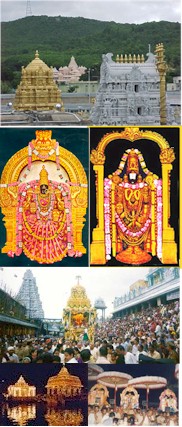Welcome to Adiyen Sri Ramanuja Dasan !
" Srimathe Ramanujaya Namaha !"
96. Q .: Why Dhwajarohanam is performed during evenings in Tirumala Temple and mostly during mornings in other Temples?
Ans .: To understand the reasons behind Dvajarohanam being performed in Tirumala in the evening, I will give you a brief intro on 'Mirasi' System which was prevalent in the olden days.
From time immemorial, the tirumala temple is being maintained by different people who perform different duties like Archakas, Jeeyars, Potu Gamekars, Tallapakam, Golla etc., In the olden days this people for performing their duties will get the remuneration in the form of shares in prasadams that are offered in that particular festival. For example, in a Kalyanotsavam, the Archaka will get the remaining Rice, Ghee, Jaggery, Betel etc.. towards his remuneration for performing that Seva.
Like this several people will receive their shares in Sevas, towards remuneration or honorary. The people who participate in that Seva and get the remuneration in the form of kind are called Mirasidars and this system is called Mirasi system. So there are Archakam Mirasidars, Jeeyangar Mirasi, Potu Mirasi and so on.
Now coming to the Archakam Mirasidars, their duty is to perform all the rituals to Lord Srinivasa and in return they will get the remaining articles and a little share in the prasadams offered as a remuneration. In Archakam Mirasi, there were four families who render Archakatvam services in this temple. They are Gollapalli, Padipalli, Peddinti and Tirupathamma gari, named after their own villages, near by to Tirupati. Each of this family will get their turn to maintain the rituals in this temple by employing their own staff for one year. Means for 1 year the said Archakam Mirasidar is responsible for arranging for performance of all the rituals in the temple and decorations of deities with special jewels and responsibility of all the jewels or articles used in the temple.
Usually the turn period is from Dvajarohanam of current Brahmotsavams till the Ankuraropanam of the next years Brahmotsavams, for a 1 full year. So as part of the kainkaryam performance the agreement among the four families is that the current Vanthudar ( who is incharge of the current turn) is responsible to perform the rituals from this years brahmotsavam to the next year brahmotsavam. So the outgoing Vanthudar will perform the Ankurarpanam and from next day (Dvajarohanam) onwards the incoming Vanthudar will take charge with the people employed by him. So in this process there are several intricacies like submitting the Jewels, articles etc to the new vanthudar etc., Also the dvajarohanam day is usually fall on Vinayaka Chavithi. So after performing the Vinayaka Chaturthi puja, the incoming Vanthudar will appoint a Chief Acharya for the performance of the Brahmotsavam and the staff he employed as Archakas in his turn, with all this people, in his residence at Tirupati, there will be Samaradhana to all. Then they will travel from Tirupati after looking for all good signs(sakunams). In this process the time takes the day and it will be in the afternoon they reach tirumala hills.
So the chief Acharya will now take the formal resolve (Samkalpam) and the Raksha bandhanam, then he will do the Pushpa nyasam to Mulavirat, after the I bell, then in the Bali, all the dikpalakas are invited for Dvajarohanam in the four mada streets, while Malayappa Swamy with his attendent deities on the procession. Apart from this the Dvajarohanam will always takes place within Surya asthamayam according to local time. So it is said in Agamas that while the sun is in, the kriya should be completed. So it became a practice in Tirumala that the Dvajarohanam always takes place in the evening owing to all these reasons. Also in olden days when there is no transportation, with all the staff, going to tirumala was quite difficult and when they start in the morning it is almost evening, so it is fixed in Tirumala that Dvajarohanam will be held in the evening all the time.
Jai Srimannaryana !
Thanks for your valuable time. Visit our web site again for more information and latest updates.

